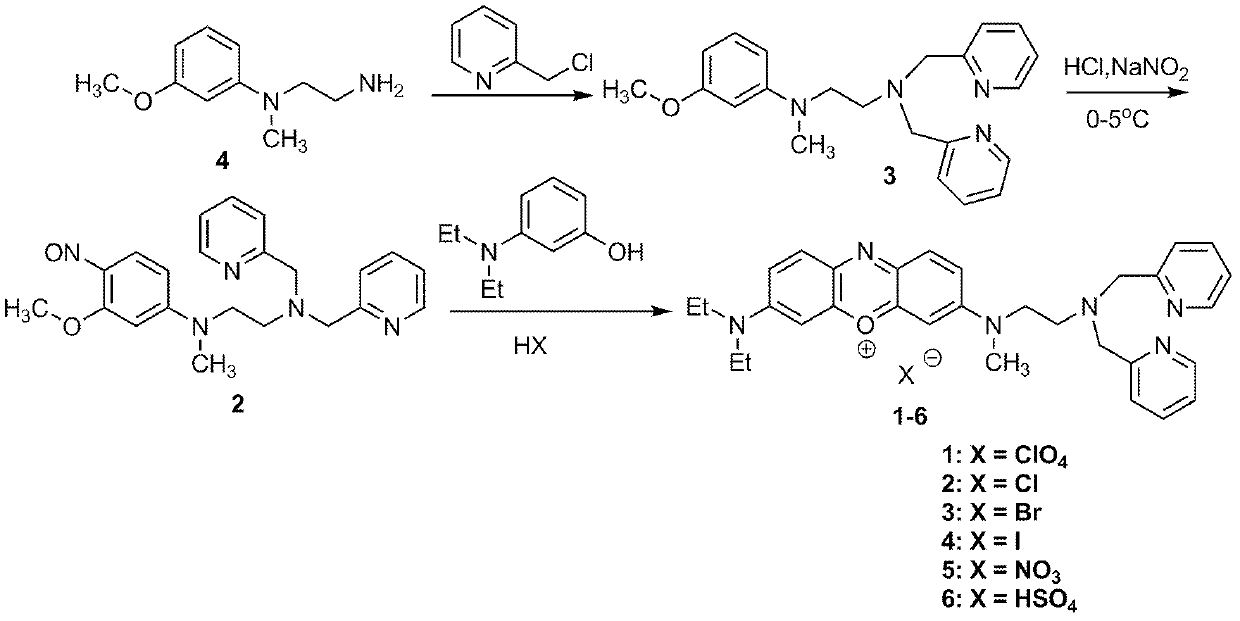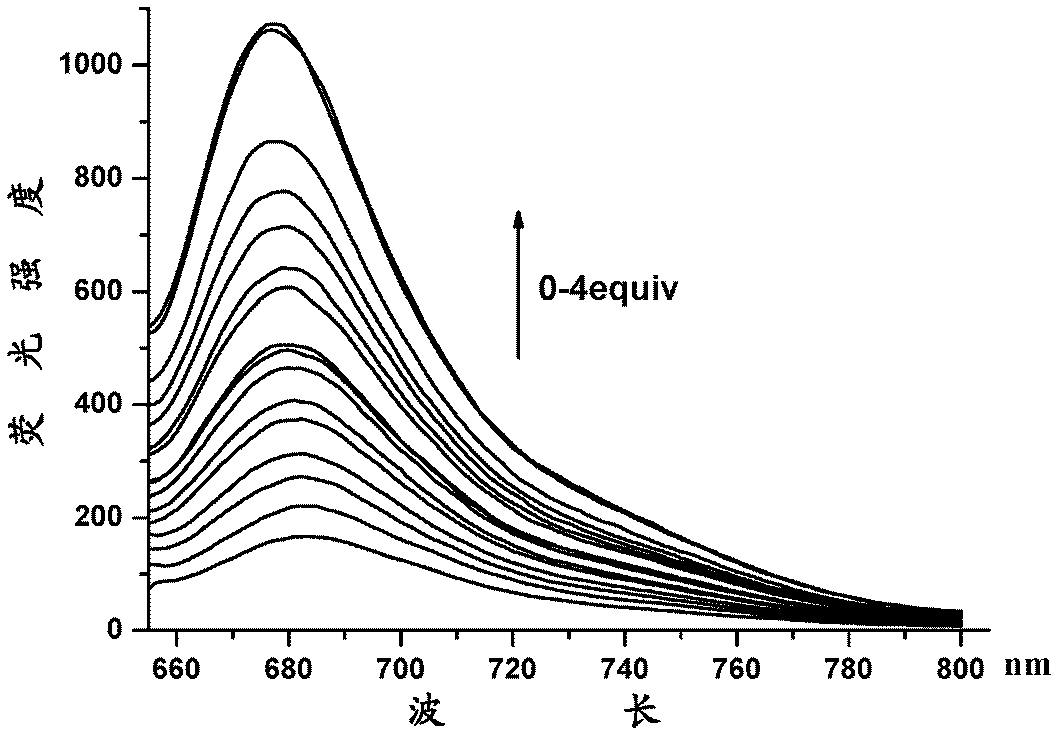Near-infrared fluorescence probe used for detecting zinc ions in water phase, preparation method thereof, and application thereof
A fluorescent probe, near-infrared technology, used in fluorescence/phosphorescence, luminescent materials, chemical instruments and methods, etc., can solve the problems of cell damage, detection interference, limitations, etc., and achieve the effect of good membrane permeability
- Summary
- Abstract
- Description
- Claims
- Application Information
AI Technical Summary
Problems solved by technology
Method used
Image
Examples
Embodiment 1
[0031] Example 1: Preparation of near-infrared fluorescent probes.
[0032] Such as figure 1As shown, 5.6g 2-chloromethylpyridine hydrochloride, 3.24g N-3-methoxyphenyl-N-methylethylenediamine (4), 2.72g sodium hydroxide, 109mg phase transfer catalyst, 5.45g of potassium iodide was dissolved in a mixed solution of 35mL of water and 35mL of tetrahydrofuran, and the above solution was reacted at room temperature for 2 days under vigorous stirring. Extracted with dichloromethane, dried, and evaporated to remove the solvent to obtain a crude product. The intermediate product N-3-methoxyphenyl-N-methyl-N',N'-bis(2-methylenepyridine)ethylenediamine (3) was obtained by silica gel column separation as a colorless oil.
[0033] The characterization data is: 1 HNMR (400MHz, CDCl 3 ): δ8.53 (d, J=4.8, 2H, 2×Ar-H), 7.63 (td, J=7.7, 1.4, 2H, 2×Ar-H), 7.50 (d, J=7.8, 2H, 2×Ar-H), 7.18-7.11(m, 2H, 2×Ar-H), 7.04(t, J=8.2, 1H, Ar-H), 6.21(d, J=8.5, 2H, 2×Ar -H), 6.17(d, J=2.0, 1H, Ar-H),...
Embodiment 2
[0044] Example 2: Zinc ion near-infrared fluorescent probe 1 (X=ClO 4 ) performance experiment.
[0045] The synthesized fluorescent probe was made into a buffer mother solution containing 1% DMSO, and then diluted to a corresponding concentration with a buffer solution to test its performance.
[0046] (1) Sensitivity analysis of zinc ion fluorescent probe:
[0047] The fluorescent probe (1) was added to aqueous solutions of different concentrations of zinc ions, and the probe concentration was 10×10 -6 M, by figure 2 It can be seen that the fluorescence emission intensity gradually increases after the addition of zinc ions. figure 2 Available image 3 . Depend on image 3 It can be seen that the fluorescence intensity of the fluorescent probe is related to the zinc ion concentration at 1×10 -6 M to 1×10 -5 In the range of M, a good linear relationship is formed, which makes it possible to quantitatively detect the concentration of zinc ions.
[0048] (2) Selective...
Embodiment 3
[0050] Example 3: Fluorescence imaging in living cells using the above-mentioned fluorescent probes.
[0051] Fluorescent probes for the detection of intracellular zinc ions see Figure 5 , it can be seen from the figure that the fluorescent probe can eliminate the interference of cell autofluorescence, and can be used for the detection of zinc ions in biological systems and the fluorescence imaging of zinc ions in living biological cells.
[0052] In summary, the zinc ion near-infrared fluorescent probe of the present invention is water-soluble, has good sensitivity, and the pretreatment of the detection sample is very simple, and the emission wavelength is in the long wavelength region, so it can be used to detect zinc ions in living cells. Detection and fluorescence imaging.
PUM
 Login to View More
Login to View More Abstract
Description
Claims
Application Information
 Login to View More
Login to View More - Generate Ideas
- Intellectual Property
- Life Sciences
- Materials
- Tech Scout
- Unparalleled Data Quality
- Higher Quality Content
- 60% Fewer Hallucinations
Browse by: Latest US Patents, China's latest patents, Technical Efficacy Thesaurus, Application Domain, Technology Topic, Popular Technical Reports.
© 2025 PatSnap. All rights reserved.Legal|Privacy policy|Modern Slavery Act Transparency Statement|Sitemap|About US| Contact US: help@patsnap.com



